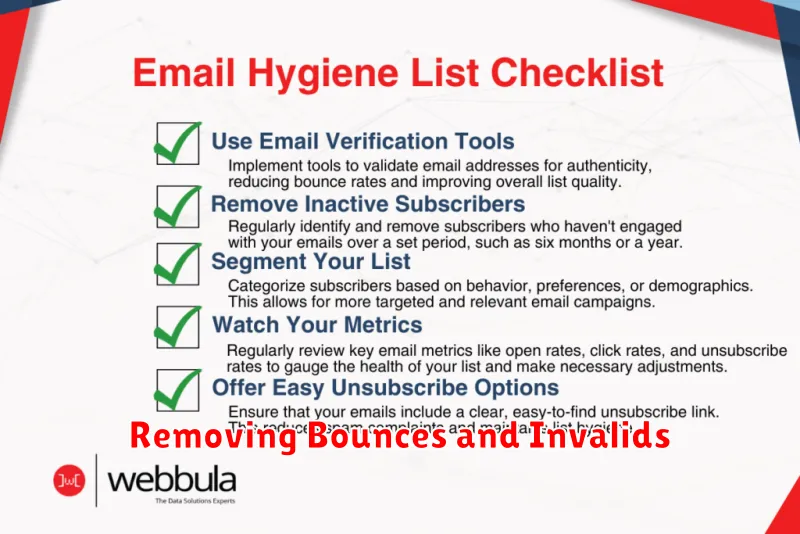Maintaining a clean and up-to-date email list is crucial for successful email marketing. Email list hygiene involves regularly cleaning your database to remove invalid, inactive, and duplicate email addresses. This process significantly improves your email deliverability rates, reduces bounce rates, and protects your sender reputation. By prioritizing email database cleaning, you can ensure that your marketing messages reach the right audience, maximize your return on investment, and foster a positive relationship with your subscribers.
Neglecting email list cleaning can lead to a variety of problems, including being flagged as a spammer. Regular database cleaning is not merely a suggestion, but a necessity for any serious email marketer. This article will delve into the essential steps for maintaining a healthy email list, covering best practices for removing inactive subscribers, handling bounces, and implementing strategies for ongoing email list hygiene. By following these guidelines, you can improve your campaign performance and cultivate a highly engaged subscriber base.
What Is Email List Hygiene?
Email list hygiene is the process of maintaining a clean and up-to-date email subscriber list. This involves regularly identifying and removing invalid, inactive, or bounced email addresses. Maintaining good list hygiene is crucial for maximizing email marketing effectiveness and protecting your sender reputation.
A clean email list ensures that your messages reach real, engaged users, minimizing bounces and spam complaints. This, in turn, improves deliverability rates and helps avoid being flagged as a spam sender by email service providers (ESPs). It also contributes to more accurate campaign metrics, allowing for better analysis and more effective strategy adjustments.
By focusing on maintaining an engaged audience, you reduce wasted resources spent sending emails to inactive or non-existent addresses. This translates to a more cost-effective email marketing strategy.
Identifying Inactive Subscribers
A key aspect of email list hygiene involves pinpointing inactive subscribers. These are individuals who haven’t engaged with your emails for a defined period. This lack of engagement can negatively impact your email deliverability and overall campaign performance.
Defining inactivity is crucial. This period can vary depending on your industry and email frequency. A common timeframe is six months to a year with no opens or clicks. You might consider a shorter timeframe if you send emails very frequently.
Several factors can contribute to subscriber inactivity. These may include:
- Changes in interests
- Inbox overload
- Forgotten subscriptions
Analyzing email metrics provides the data necessary to identify these inactive subscribers. Track opens, clicks, and last engagement date to segment your audience effectively.
Removing Bounces and Invalids

A crucial step in maintaining a healthy email list is the prompt removal of bounced email addresses and invalid entries. Bounces occur when an email cannot be delivered to the recipient’s inbox. There are two primary types: hard bounces and soft bounces.
Hard bounces signal a permanent delivery failure, often due to an invalid or non-existent email address. These should be removed from your list immediately.
Soft bounces indicate a temporary issue, such as a full inbox or server problem. While not requiring immediate removal, repeated soft bounces from the same address suggest a potential problem and warrant further investigation or eventual removal.
Invalid entries, similar to hard bounces, represent email addresses that are incorrectly formatted or contain typos. Identifying and removing these prevents unnecessary sends and improves your sender reputation. Utilizing email verification services during the signup process can significantly reduce the number of invalid entries from the start.
Regularly cleaning your list of bounces and invalids is essential for maximizing deliverability and maintaining a positive sender reputation. This ensures that your messages reach engaged subscribers and minimizes the risk of being flagged as spam.
Re-Engagement Campaigns
Before removing inactive subscribers, consider implementing a re-engagement campaign. This is a strategic effort to reconnect with subscribers who haven’t interacted with your emails recently. A well-executed campaign can rekindle interest and prevent unnecessary removals.
Types of Re-Engagement Campaigns:
- Incentivized Campaigns: Offer a special discount, free shipping, or exclusive content to entice inactive subscribers to re-engage.
- Preference Updates: Provide an opportunity for subscribers to update their email preferences, allowing them to choose the type of content they receive and the frequency.
- Feedback Surveys: Ask subscribers why they haven’t been engaging and what kind of content they’d like to see. This valuable feedback can inform your future email marketing strategy.
Key Considerations:
- Targeted Messaging: Craft compelling subject lines and email copy that resonates with inactive subscribers. Highlight the value they’re missing out on.
- Limited Time Offers: Create a sense of urgency with limited-time offers to encourage immediate action.
- Clear Call to Action: Make it easy for subscribers to re-engage with a clear and prominent call to action.
Segmenting Engaged Users
Once you’ve removed inactive subscribers and cleaned your email list, the next crucial step is segmenting your remaining engaged users. This allows for more targeted and effective email marketing campaigns.
Segmentation involves dividing your subscribers into smaller groups based on shared characteristics or behaviors. This allows you to tailor your messaging and offers to specific audience segments, increasing the relevance of your communications.
Common Segmentation Criteria:
- Demographics: Age, gender, location
- Purchase history: Past products purchased, purchase frequency, average order value
- Website activity: Pages visited, content downloaded, time spent on site
- Email engagement: Open rates, click-through rates, email preferences
By analyzing these factors, you can identify patterns and create segments that respond well to specific types of content and offers. For example, customers who frequently purchase a particular product might be interested in exclusive deals or new product releases within that category.
Effective segmentation leads to improved open rates, click-through rates, and ultimately, conversions. It also helps to reduce unsubscribe rates by ensuring subscribers receive content relevant to their interests.
Improving Deliverability
Maintaining a clean email list is crucial for improving deliverability. Deliverability refers to the ability of your emails to successfully reach recipients’ inboxes. A high bounce rate, spam complaints, and low engagement signal to email providers that your list is of poor quality, potentially leading to your emails being flagged as spam.
Removing invalid email addresses is the first step. These include addresses with typos, inactive accounts, or domains that no longer exist. This process greatly reduces bounce rates and improves your sender reputation.
Managing unsubscribes promptly is equally important. Make it easy for recipients to opt-out of your emails. Respecting their preferences prevents spam complaints and maintains a positive relationship with your subscribers, even if they choose to no longer receive your communications.
Regularly monitoring engagement metrics, such as open and click-through rates, can identify inactive subscribers. Consider implementing a re-engagement campaign for those who haven’t interacted with your emails in a set period. If they remain unresponsive, removing them from your list is the best course of action.

